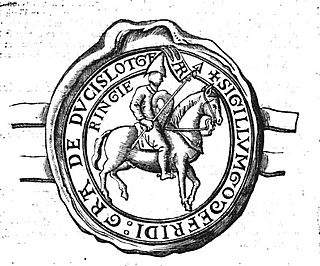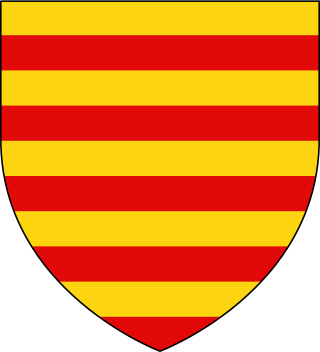
The County of Loon was a county in the Holy Roman Empire, which corresponded approximately with the Belgian province of Limburg. It was named after the original seat of its count, Loon, which is today called Borgloon. During the middle ages the counts moved their court to a more central position in Kuringen, which is today a part of Hasselt, the modern capital of the region.

Godfrey I, called the Bearded, the Courageous, or the Great, was the Landgrave of Brabant, Count of Brussels and Leuven (Louvain) from 1095 to his death and Duke of Lower Lorraine from 1106 to 1129. He was also Margrave of Antwerp from 1106 to his death.
The County of Metz originated from the frankish Metzgau. In the second half of the 9th century it went to the Gerhardiner (de), which held at the same time the County of Paris.
Giselbert van Loon is the first definitely known count of the County of Loon, a territory which, at least in later times, roughly corresponded to the modern Belgian province of Limburg, and generations later became a lordship directly under the Prince-bishopric of Liège. Very little is known about him except that he had two brothers, one of whom, Bishop Balderic II of Liège, is much better attested in historical records.

Arnold IV of Loon (Looz) (died between November 1272 and October 1273; most likely on February 22, 1273), was Count of Loon from 1227 to 1273 and Count of Chiny (as Arnold II) from 1228 to 1268. He was the son of Gérard III, Count of Rieneck and Cunegonde von Zimmern.

Louis I was the Count of Loon, now in modern Belgium, and Burgrave of Mainz, in Germany. He inherited these offices from his father. He also established the County of Rieneck apparently based upon the Burgrave's lands.
The counts of Chiny were part of the nobility of Lotharingia that ruled from the 9th to the 14th century in what is now part of Belgium.
Otto II, Count of Chiny, son of Arnold I, Count of Chiny, and Adélaïs.

Arnold V de Looz, was Count of Loon from 1279 to 1323 and Count of Chiny from 1299 to 1310. He was the son of John I, Count of Looz and Mathilde Jülich.
Godfrey de Heinsberg, Lord of Daelenbroeck, Count of Looz and Count of Chiny (1361–1362), son of John of Heinsberg, Lord of Daelenbroeck.
Otto is a purported Count of Loon and father of Count Giselbert, who would have been adult roughly around the years 980–1000. He appears in only one much later document that is considered unreliable, so his existence is doubted. The list of the counts of Loon is normally started with Giselbert.
Count Emmo, Immo or Emmon is one of the first known counts of Loon in the region of modern Belgian Limburg. Before him one more count is known with confidence, Count Giselbert, but it is not certain that Giselbert was Emmo's father. Verhelst for example has proposed that he was his uncle, and that Giselbert's brother Count Arnulf was father of Emmo and also a count of Loon.

Arnold II, Count of Loon, son of Arnold I, Count of Loon, and Agnes von Mainz, daughter of Gerhard I, Count of Rieneck, and Helwig von Bliescastel. He is distinguished from his father of the same name by historians who note records for counts named Arnold or Arnulf between 1179 and 1141. The first Arnold must have died between 1125 when Count Arnold appears in a record with his son also named Arnold, and 1135, when a new Count Arnold appears with his own son and successor Louis.
Count Gerard of Loon, was son and successor of Louis I, Count of Loon, and Agnes of Metz. He was count of Loon and of Rieneck. Because of a widespread misunderstanding concerning a document from 1101, some generations earlier, he is sometimes wrongly referred to as the second Gerard in this dynasty, "Gerard II".
Arnold III, Count of Looz and Count of Rieneck, son of Gérard II, Count of Looz, and Adelaide of Gelderland, daughter of Henry I, Count of Guelders, and Agnes of Arnstein, daughter of Louis III of Arnstein.
Gerard, Count of Rieneck, son of Gerard, Count of Loon, and Adelaide of Gelderland, daughter of Henry I, Count of Guelders, and Agnes of Arnstein, daughter of Louis III of Arnstein.
Louis III, Count of Looz, also known as Ludwig was Count of Loon and of Rieneck. He was the son of Gerard, Count of Rieneck, and Cunegonde von Zimmern, who was in turn the son of another Count Gerard who was also count of both Rieneck and Loon.
Count Giselbert of Loon or (later) Duras, was the deputy advocate (subadvocatus) of Saint Trudo’s Abbey. He was son of Otto I, Count of Duras, and his wife Oda. Giselbert was the first person to be named in contemporary documents as a count of Duras.
Godefroi, Count of Durbuy, son of Henry I, Count of Durbuy.

During the Middle Ages, the County of Moha was a small territory in the pagus of Hesbaye in the Duchy of Lower Lorraine in the Holy Roman Empire, in what is now eastern Belgium. It was centred around the village of Moha on the right bank of the river Mehaigne and its nearby castle.